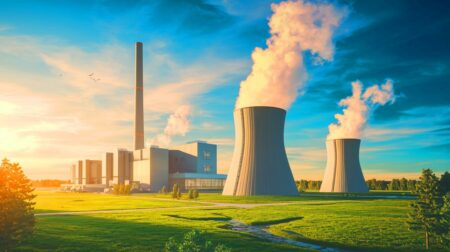As Europe re-evaluates nuclear power in the face of a looming energy crisis, new nuclear technologies like small modular reactors (SMRs) may prove an option for generating low-carbon energy in the manufacturing sector. That vision is taking hold in the United States, where chemical giant Dow has announced plans to deploy SMR units to power one of its Gulf Coast facilities by 2030.
Dow will partner with X-energy, based in Rockville, Maryland, to install its Xe-100 systems at the site. The Xe-100 is a high-temperature gas reactor designed to work as a single 80-megawatt (MW) electric unit, but also in a configuration of four units to build a “power plant” that delivers 320 MW of electricity. In the industrial setting, each unit delivers 200 MW in thermal output for high-pressure steam generation.
X-energy has been working on what is one of the first grid-scale advanced reactor plants in North America, located in Washington state, and signed an agreement in July with Ontario Power Generation in Canada to begin work on SMR deployment in the industrial sector there.
But the Nuclear Energy Institute, a nuclear industry advocacy organization, says Dow’s commitment to SMR technology is the first by a U.S.-based manufacturer.
“Advanced small modular nuclear technology is going to be a critical tool for Dow’s path to zero-carbon emissions and our ability to drive growth by delivering low-carbon products to our customers,” says Dow CEO Jim Fitterling. “X-energy’s technology is among the most advanced, and when deployed will deliver safe, reliable, low-carbon power and steam.”
The high-efficiency SMR designed by X-energy operates on a continuous cycle at temperatures of 750 Celsius or more for maximum energy extraction. More than 200,000 fuel pebbles, each about the size of a billiards ball and embedded with 18,000 TRISO particles, pass through the SMR core in an uninterrupted stream. Super-heated helium gas then powers a steam turbine to generate carbon-free energy.
TRISO particles are made up of a uranium, carbon and oxygen fuel core within three layers of carbon- and ceramic-based materials. They can be used in both the high-temperature gas SMRs, like the Xe-100, or in molten salt-cooled reactors.
The U.S. Department of Energy says decades of development and testing makes the TRISO fuel source both safe and efficient for use, with the particles themselves serving as their own containment vessels.
“Simply put, TRISO particles cannot melt in a reactor and can withstand extreme temperatures that are well beyond the threshold of current nuclear fuels,” the department says. The SMRs that Dow plans to use each have a design life of about 60 years, and X-energy says they’re meltdown-proof.
Dow’s deployment will advance a corporate goal of reducing net annual carbon emissions by 5 million
metric tons by 2030 and becoming carbon neutral by 2050. The 2030 target represents a 15% reduction from Dow’s 2020 baseline and a 30% reduction since 2005, the company reports.
Dow also plans reductions at the Terneuzen manufacturing site in the Netherlands through a new hydrogen plant. It’s expected to reduce carbon emissions by 40% by 2030. Facilities in Spain, the United Kingdom, Sweden, France and Germany also are under 100% renewable energy agreements.
https://www.youtube.com/watch?v=0OO6BwMqN1k
Did you like it? 4.3/5 (28)








